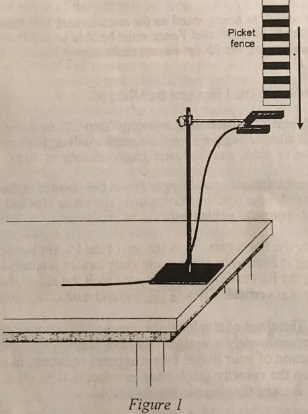Experiment - Picket Fence Free Fall
OBJECTIVE - Measure the acceleration of a freely falling body (g) to better than 0.5% precision using a Picket Fence and a Photogate.

PRELIMINARY QUESTIONS
1. Inspect your Picket Fence. You will be dropping it through a Photogate to measure g. The distance, measured from one edge of a black band to the same edge of the next band, is 5.0 cm. What additional information will you need to determine the average speed of the Picket Fence as it moves through the Photogate?
2. If an object is moving with constant acceleration, what is the shape of its velocity vs. time graph?
3. Does the initial velocity of an object have anything to do with its acceleration? For example, compared to dropping an object, if you throw it downward would the acceleration be different after you released it?
PROCEDURE
1. Fasten the Photogate rigidly to a ring stand so the arms extend horizontally, as shown in Figure 1. The entire length of the Picket Fence must be able to fall freely through the Photogate. To avoid damaging the Picket Fence, make sure it has a soft surface (such as a carpet) to land on.
2. Connect the Photogate to the DG 1 input on the ULI.
3. Prepare the computer for data collection by opening "Exp 05" from the Physics with Computers experiment files of Logger Pro. Two graphs will appear on the screen. The top graph displays distance vs. time, and the lower graph velocity vs. time.
4. Observe the reading in the status bar of Logger Pro at the bottom of the screen. Block the Photogate with your hand; note that the Photogate is shown as blocked. Remave your hand and the display should change to unblocked.
5. Click collect to prepare the Photogate. Hold the top of the Picket Fence and drop it through the Photogate, releasing it from your grasp completely before it enters the Photogate. Be careful when releasing the Picket Fence. It must not touch the sides of the Photogate as it falls and it needs to remain vertical. Click stop to end data collection.
6. Examine your graphs. The slope of a velocity vs. time graph is a measure of acceleration. If the velocity graph is approximately a straight line of constant slope, the acceleration is constant. If the acceleration of your Picket Fence appears constant, fit a straight line to your data. To do this, click on the velocity graph once to select it, then click M to fit the line y = mx + b to the data. Record the slope in the data table.
7. To establish the reliability of your slope measurement, repeat Steps 5 and 6 five more times. Do not use drops in which the Picket Fence hits or misses the Photogate. Record the slope values in the data table.
ANALYSIS
1. From your six trials, determine the minimum, maximum, and average values for the acceleration of the Picket Fence. Record them in the data table.
2. Describe in words the shape of the distance vs. time graph for the free fall.
3. Describe in words the shape of the velocity vs. time graph. How is this related to the shape of the distance vs. time graph?
4. The average acceleration you determined represents a single best value, derived from all your measurements. The minimum and maximum values give an indication of how much the measurements can vary from trial to trial; that is, they indicate the precision of your measurement. One way of stating the precision is to take half of the difference between the minimum and maximum values and use the result as the uncertainty of the measurement. Express your final experimental result as the average value, ± the uncertainty. Round the uncertainty to just one digit and round the average value to the same decimal place. For example, if your minimum, average and maximum values are 9.12, 9.93, and 10.84 m/s2, express your result as g = 9.9 ± 0.9 m/s . Record your values in the data table
5. Express the uncertainty as a percentage of the acceleration. This is the precision of your experiment. Enter the value in your data table. Using the example numbers from the last step, the precision would be
0.9/9.9 x100% = 9%
6. Compare your measurement to the generally accepted value of g (from a textbook or other source). Does the accepted value fall within the range of your values? If so, your experiment agrees with the accepted value.
7. Inspect your velocity graph. How would the associated acceleration vs. time graph look? Sketch your prediction on paper. Now change the upper graph to acceleration vs. time. Do this by clicking on the y-axis label. Select Acceleration, then deselect Distance and click OK. Comment on any differences. You may want to rescale the graph so that the acceleration axis begins at zero.
8. Using the acceleration vs. time graph on the screen, click on M to determine the average acceleration. How does this compare with the acceleration value for the same drop, determined from the slope of the velocity graph?